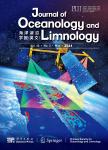Three-dimensional numerical simulation of internal tides that radiated from the Luzon Strait into the Western Pacific
Three-dimensional numerical simulation of internal tides that radiated from the Luzon Strait into the Western Pacific作者机构:Institute of OceanologyChinese Academy of Sciences Key Laboratory of Ocean Circulation and Waves (KLOCAW)Chinese Academy of Sciences University of Chinese Academy of Sciences Laboratory for Ocean and Climate DynamicsQingdao National Laboratory for Marine Science and Technology
出 版 物:《Chinese Journal of Oceanology and Limnology》 (中国海洋湖沼学报(英文版))
年 卷 期:2017年第35卷第6期
页 面:1275-1286页
核心收录:
基 金:Supported by the National Natural Science Foundation of China(Nos.41528601,41376029,U1406401,41421005) the Strategic Pioneering Research Program of CAS(Nos.XDA10020104,XDA10020101) the CAS Interdisciplinary Innovation Team“Ocean Mesoscale Dynamical Processes and ecological effect”
主 题:internal tides numerical simulation Luzon Strait Western Pacific
摘 要:Recent satellite altimeter observations have indicated that internal tides (ITs) from the Luzon Strait (LS) propagate more than 2 500 km into the Western Pacific (WP). This study used a high-resolution three-dimensional numerical model to reproduce and examine the ITs radiation process. The propagation of diurnal and semidiurnal ITs showed different patterns and variations. Diurnal ITs with lower frequency were affected more by the earth's rotation and they were bent more toward the equator than semidiurnal ITs. ITs phase speeds are functions of latitude and diurnal ITs showed greater distinctions of phase speeds during propagation. For M2 ITs, the wavelength remained nearly unchanged but the beam width increased significantly during propagation away from the LS. For diurnal ITs (K1 and O0, the wavelength decreased noticeably with latitude, while the beam width varied little during propagation because of blocking by land. Baroclinic energy was also examined as a complement to satellite results reported by Zhao (2014). The magnitude of the generated baroclinic energy flux reduced remarkably within 300 km from the generation site but it then decayed slowly when propagating into abyssal sea. Baroclinic energy of diurnal ITs was found to dissipate at a slower rate than semidiurnal ITs along the main propagation path in the WP.



